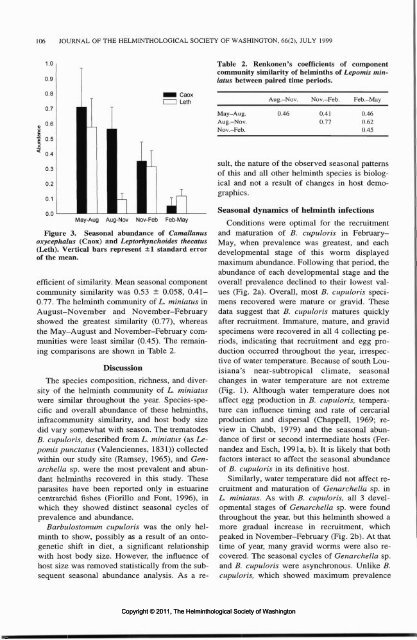The Helminthological Society of Washington - Peru State College
The Helminthological Society of Washington - Peru State College
The Helminthological Society of Washington - Peru State College
You also want an ePaper? Increase the reach of your titles
YUMPU automatically turns print PDFs into web optimized ePapers that Google loves.
106 JOURNAL OF THE HELMINTHOLOGICAL SOCIETY OF WASHINGTON, 66(2), JULY 1999<br />
Table 2. Renkonen's coefficients <strong>of</strong> component<br />
community similarity <strong>of</strong> helminths <strong>of</strong> Lepomis miniatus<br />
between paired time periods.<br />
Caox<br />
Leth<br />
May-Aug.<br />
Aug.—Nov.<br />
Nov.-Feb.<br />
Aug.-Nov. Nov.—Feb. Feb.—May<br />
0.46 0.41<br />
0.77<br />
0.46<br />
0.62<br />
0.45<br />
suit, the nature <strong>of</strong> the observed seasonal patterns<br />
<strong>of</strong> this and all other helminth species is biological<br />
and not a result <strong>of</strong> changes in host demographics.<br />
May-Aug Aug-Nov Nov-Feb Feb-May<br />
Figure 3. Seasonal abundance <strong>of</strong> Camallanus<br />
oxycephalus (Caox) and Leptorhynchoides thecatus<br />
(Leth). Vertical bars represent ±1 standard error<br />
<strong>of</strong> the mean.<br />
efficient <strong>of</strong> similarity. Mean seasonal component<br />
community similarity was 0.53 ± 0.058, 0.41-<br />
0.77. <strong>The</strong> helminth community <strong>of</strong> L. miniatus in<br />
August-November and November-February<br />
showed the greatest similarity (0.77), whereas<br />
the May-August and November-February communities<br />
were least similar (0.45). <strong>The</strong> remaining<br />
comparisons are shown in Table 2.<br />
Discussion<br />
<strong>The</strong> species composition, richness, and diversity<br />
<strong>of</strong> the helminth community <strong>of</strong> L. miniatus<br />
were similar throughout the year. Species-specific<br />
and overall abundance <strong>of</strong> these helminths,<br />
infracommunity similarity, and host body size<br />
did vary somewhat with season. <strong>The</strong> trematodes<br />
B. cupuloris, described from L. miniatus (as Lepomis<br />
punctatus (Valenciennes, 1831)) collected<br />
within our study site (Ramsey, 1965), and Genarchella<br />
sp. were the most prevalent and abundant<br />
helminths recovered in this study. <strong>The</strong>se<br />
parasites have been reported only in estuarine<br />
centrarchid fishes (Fiorillo and Font, 1996), in<br />
which they showed distinct seasonal cycles <strong>of</strong><br />
prevalence and abundance.<br />
Barbulostomum cupuloris was the only helminth<br />
to show, possibly as a result <strong>of</strong> an ontogenetic<br />
shift in diet, a significant relationship<br />
with host body size. However, the influence <strong>of</strong><br />
host size was removed statistically from the subsequent<br />
seasonal abundance analysis. As a re-<br />
Seasonal dynamics <strong>of</strong> helminth infections<br />
Conditions were optimal for the recruitment<br />
and maturation <strong>of</strong> B. cupuloris in February-<br />
May, when prevalence was greatest, and each<br />
developmental stage <strong>of</strong> this worm displayed<br />
maximum abundance. Following that period, the<br />
abundance <strong>of</strong> each developmental stage and the<br />
overall prevalence declined to their lowest values<br />
(Fig. 2a). Overall, most B. cupuloris specimens<br />
recovered were mature or gravid. <strong>The</strong>se<br />
data suggest that B. cupuloris matures quickly<br />
after recruitment. Immature, mature, and gravid<br />
specimens were recovered in all 4 collecting periods,<br />
indicating that recruitment and egg production<br />
occurred throughout the year, irrespective<br />
<strong>of</strong> water temperature. Because <strong>of</strong> south Louisiana's<br />
near-subtropical climate, seasonal<br />
changes in water temperature are not extreme<br />
(Fig. 1). Although water temperature does not<br />
affect egg production in B. cupuloris, temperature<br />
can influence timing and rate <strong>of</strong> cercarial<br />
production and dispersal (Chappell, 1969; review<br />
in Chubb, 1979) and the seasonal abundance<br />
<strong>of</strong> first or second intermediate hosts (Fernandez<br />
and Esch, 199la, b). It is likely that both<br />
factors interact to affect the seasonal abundance<br />
<strong>of</strong> B. cupuloris in its definitive host.<br />
Similarly, water temperature did not affect recruitment<br />
and maturation <strong>of</strong> Genarchella sp. in<br />
L. miniatus. As with B. cupuloris, all 3 developmental<br />
stages <strong>of</strong> Genarchella sp. were found<br />
throughout the year, but this helminth showed a<br />
more gradual increase in recruitment, which<br />
peaked in November-February (Fig. 2b). At that<br />
time <strong>of</strong> year, many gravid worms were also recovered.<br />
<strong>The</strong> seasonal cycles <strong>of</strong> Genarchella sp.<br />
and B. cupuloris were asynchronous. Unlike B.<br />
cupuloris, which showed maximum prevalence<br />
Copyright © 2011, <strong>The</strong> <strong>Helminthological</strong> <strong>Society</strong> <strong>of</strong> <strong>Washington</strong>
















